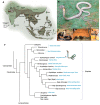King Cobra and snakebite envenomation: on the natural history, human-snake relationship and medical importance of Ophiophagus hannah
- PMID: 35069710
- PMCID: PMC8733962
- DOI: 10.1590/1678-9199-JVATITD-2021-0051
King Cobra and snakebite envenomation: on the natural history, human-snake relationship and medical importance of Ophiophagus hannah
Abstract
King Cobra (Ophiophagus hannah) has a significant place in many cultures, and is a medically important venomous snake in the world. Envenomation by this snake is highly lethal, manifested mainly by neurotoxicity and local tissue damage. King Cobra may be part of a larger species complex, and is widely distributed across Southeast Asia, southern China, northern and eastern regions as well as the Western Ghats of India, indicating potential geographical variation in venom composition. There is, however, only one species-specific King Cobra antivenom available worldwide that is produced in Thailand, using venom from the snake of Thai origin. Issues relating to the management of King Cobra envenomation (e.g., variation in the composition and toxicity of the venom, limited availability and efficacy of antivenom), and challenges faced in the research of venom (in particular proteomics), are rarely addressed. This article reviews the natural history and sociocultural importance of King Cobra, cases of snakebite envenomation caused by this species, current practice of management (preclinical and clinical), and major toxinological studies of the venom with a focus on venom proteomics, toxicity and neutralization. Unfortunately, epidemiological data of King Cobra bite is scarce, and venom proteomes reported in various studies revealed marked discrepancies in details. Challenges, such as inconsistency in snake venom sampling, varying methodology of proteomic analysis, lack of mechanistic and antivenomic studies, and controversy surrounding antivenom use in treating King Cobra envenomation are herein discussed. Future directions are proposed, including the effort to establish a standard, comprehensive Pan-Asian proteomic database of King Cobra venom, from which the venom variation can be determined. Research should be undertaken to characterize the toxin antigenicity, and to develop an antivenom with improved efficacy and wider geographical utility. The endeavors are aligned with the WHO´s roadmap that aims to reduce the disease burden of snakebite by 50% before 2030.
Keywords: Antivenom; Neglected tropical disease; Neutralization; Proteomics; Venomics.
Conflict of interest statement
Competing interests: The authors declare that they have no competing interests.
Figures







Similar articles
-
Frequency, geographical distribution, clinical characteristics, antivenom utilisation and outcomes of King Cobra (Ophiophagus hannah) bites in Malaysia.PLoS Negl Trop Dis. 2024 Jul 25;18(7):e0012359. doi: 10.1371/journal.pntd.0012359. eCollection 2024 Jul. PLoS Negl Trop Dis. 2024. PMID: 39052675 Free PMC article.
-
Geographical variations in king cobra (Ophiophagus hannah) venom from Thailand, Malaysia, Indonesia and China: On venom lethality, antivenom immunoreactivity and in vivo neutralization.Acta Trop. 2020 Mar;203:105311. doi: 10.1016/j.actatropica.2019.105311. Epub 2019 Dec 17. Acta Trop. 2020. PMID: 31862461
-
The Royal Armoury: Venomics and antivenomics of king cobra (Ophiophagus hannah) from the Indian Western Ghats.Int J Biol Macromol. 2023 Dec 31;253(Pt 2):126708. doi: 10.1016/j.ijbiomac.2023.126708. Epub 2023 Sep 9. Int J Biol Macromol. 2023. PMID: 37673142
-
Composition, pharmacology, and pathophysiology of the venom of monocled cobra (Naja kaouthia)- a medically crucial venomous snake of southeast Asia: An updated review.Toxicon. 2024 Oct;249:108056. doi: 10.1016/j.toxicon.2024.108056. Epub 2024 Aug 5. Toxicon. 2024. PMID: 39111718 Review.
-
Mass spectrometric analysis to unravel the venom proteome composition of Indian snakes: opening new avenues in clinical research.Expert Rev Proteomics. 2020 May;17(5):411-423. doi: 10.1080/14789450.2020.1778471. Epub 2020 Jun 24. Expert Rev Proteomics. 2020. PMID: 32579411 Review.
Cited by
-
Equatorial Spitting Cobra (Naja sumatrana) from Malaysia (Negeri Sembilan and Penang), Southern Thailand, and Sumatra: Comparative Venom Proteomics, Immunoreactivity and Cross-Neutralization by Antivenom.Toxins (Basel). 2022 Jul 29;14(8):522. doi: 10.3390/toxins14080522. Toxins (Basel). 2022. PMID: 36006183 Free PMC article.
-
The Effect of Purified Opharin Isolated from the Venom of King Cobra (Ophiophagus hannah) in Modulating Macrophage Inflammatory Responses and Vascular Integrity.Toxins (Basel). 2024 Dec 19;16(12):550. doi: 10.3390/toxins16120550. Toxins (Basel). 2024. PMID: 39728808 Free PMC article.
-
Identification of antigenic proteins from the venom of Malaysian snakes using immunoprecipitation assay and tandem mass spectrometry (LC-MS/MS).Heliyon. 2024 Sep 1;10(17):e37243. doi: 10.1016/j.heliyon.2024.e37243. eCollection 2024 Sep 15. Heliyon. 2024. PMID: 39286227 Free PMC article.
-
Frequency, geographical distribution, clinical characteristics, antivenom utilisation and outcomes of King Cobra (Ophiophagus hannah) bites in Malaysia.PLoS Negl Trop Dis. 2024 Jul 25;18(7):e0012359. doi: 10.1371/journal.pntd.0012359. eCollection 2024 Jul. PLoS Negl Trop Dis. 2024. PMID: 39052675 Free PMC article.
-
The Target Selects the Toxin: Specific Amino Acids in Snake-Prey Nicotinic Acetylcholine Receptors That Are Selectively Bound by King Cobra Venoms.Toxins (Basel). 2022 Aug 1;14(8):528. doi: 10.3390/toxins14080528. Toxins (Basel). 2022. PMID: 36006190 Free PMC article.
References
-
- World Health Organization . Guidelines for the management of snakebites WHO Regional Office for Southeast Asia. 2016.
-
- Gutierrez JM, Calvete JJ, Habib AG, Harrison RA, Williams DJ, Warrell DA. Snakebite envenoming. Nat Rev Dis Primers. 2017;3:17063. - PubMed
-
- World Health Organization . Fact Sheets. 2021. [20 June 2021]. Snakebite envenoming. In Fact Sheets https://www.who.int/news-room/fact-sheets/detail/snakebite-envenoming .
Publication types
LinkOut - more resources
Full Text Sources
